2006.02.06 18:28
Thesis Semester [blog] 25 years ago
Because of Roma Interrotta and related genius loci issues, I've been doing a lot of reading/research, and thus I now know that when I look out my mother's living room windows I'm looking at the site where the oldest house in Pennsylvania once stood.
2006.02.08 15:10
Thesis Semester [blog] 25 years ago
Late Sunday afternoon I used my parallel rule and even a compass. The Admnistration Building at the Academy of the New Church is a reenactment of Kahn's Goldenberg House (which was designed for a site in Rydel, Pennsylvania, further south down Huntington Pike). The plan analysis of the Administration Building is still inconclusive, so now it's back to CAD.
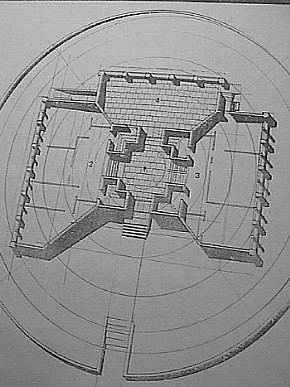
c0213
2006.02.14 11:23
non-event cities
There used to be many stores in Philadelphia just like I. Goldbergs. The quondam Bond Linen on 5th Street in Olney was exactly like I. Goldbergs, except for bedding, etc. And I wonder how many people still remember South Street before it became "South Street"--I still vividly remember going shopping there with my parents for a leather coat for my brother back in the late sixties--there were several blocks of men's clothing stores, and the salesmen would literally grab you on the street drag you into the store. Quite the 'event'.
| |
2006.02.14 18:43
non-event cities
When I was very little, probably in 1960, about once a month on Friday nights my parents would take me and my brother to "the south." I can still vividly remember my first trip there because it seemed like we went to Hell. We were first greeted by multiple barrels in the street with open flames coming out their tops, and lots of noise and smells and trash everywhere, and there were dead animals all over the place, I mean dead fish and dead rabbits and dead chickens, and I got really afraid when I saw my father going into a big dark room with dead pigs and cows hanging in it. Of course, my older brother was no help because he made me touch the dead animals as we walked by them.
After several trips my brother and I put up such a fuss that we were allowed to stay home, and I never wanted to go to "the south" again.
Fifteen years later in my first year of architecture school, the teachers wanted us students to learn and experience the city, "and everyone should go to the Italian Market in South Philadelphia, it's vibrant and lively."
2006.03.10 12:03
Thesis Semester [blog] 25 years ago
Hal told R., on the subway on the way to a Giurgola(?) lecture at Penn, "It's [my mid-term design] a bit too facile." Hal told me it wasn't Philadelphian enough. Thus, for part of Spring Break I'm gonna go around and look at notable Philadelphia buildings. I think Hal was also saying my design was a little too much something other than Philadelphian. I distinctly remember going to see the Richard's Medical Buildings, and for some reason the Merchant Exchange impressed me the most.
Did I also visit Franklin Court? Since I remember Hal and I talking about it--it is mostly an underground museum after all--I guess I did go there. I especially remember how much Hal admired the "Franklin - Man of Infinite Dimension" room and how the reverse lettered neon was then correctly read in the mirrors. I took pictures of just that phenomenon 21 November 1998, for sure thinking of Hal while I did so.
2006.03.19 17:55
non-event cities
I don't know about you, but as far as architectural history is concerned, I think it's worth remembering that demolition of the Liberty Bell Pavilion is set to begin on the third anniversary of the US invasion of Iraq.
2006.03.20
INHP/Liberty Bell Pavilion
2006.03.21 10:23
FUNCTION - physical or metaphysical
What are some examples of buildings that are "designed too specifically for its function"?
What happens when the function still exists, but the community moves away?
Do you know how many original synagogues in Philadelphia are not synagogues anymore? Do you know how many original Roman Catholic Churches in Philadelphia are not Roman Catholic Churches anymore?
| |
2006.03.21 10:57
FUNCTION - physical or metaphysical
My point was that now-a-days communities are just as ephemeral as functions.
I knew factories would come up in terms of functionally specific architecture, mostly because the functional aesthetic in architecture was pretty much inspired by factories.
What a "community" keeps is in large measure contingent on how a building is zoned (or rezoned 'residential'). Here in Philadelphia religious buildings tend to stay religious buildings, and religious buildings "function" mostly because they are tax exempt.
Don't get me wrong though, I'm all for re-use before demolition. I mean, how else could I look at a Cambodian Buddhist Temple after I walk out of the Rite-Aid?
2006.06.03
Philadelphia Museum of Art
2006.04.01 14:24
Why does much 'avant-garde' design these days look straight out of the Sixties?
...I was reminded of being in a local 1960s Roman Catholic church for the first time a few years ago. I was actually quite surprised by it's "radical-ness". I mean, it was the first time I've ever seen a completely black altar in my life. There was indeed something radical about a lot of 60s and 70s architecture.
2006.04.27
Ichnographia Ottopia
...put the plan of Whitemarsh Hall into the Philadelphia Museum of Art, and then use other plans as indicative of period rooms.
2006.05.01 14:33
paris 2054
The dead Piranesi likes Philadelphia because of the design Benjamin Franklin Parkway.
Plus, almost 240 years after Piranesi secretly changed the Ichnographia Campi Martii into a second state, the two version of the large plan were finally discovered in Philadelphia. Piranesi made the secret changes only to see who would ultimately discover them.
2006.05.05 16:55
Architectural Criticism
Goeff, it's not true when you say, "And no one says a thing." If you would read A Quondam Banquet of Virtual Sachlichkeit: Part I and A Quondam Banquet of Virtual Sachlichkeit: Part II you would see that a whole bunch has already been said/written within the realm of architectural criticism about the built environment that you say is being ignored. I think you ignore a lot about present-day architecture criticism yourself!
And I love my local Home Depot--it's on the site of the world's largest building implosion, right in Philadelphia no less. Certainly not a place I ignore.
2006.05.05 17:25
Architecture Writers in Philadelphia...
...of the last hundred years or so.
.00
Kimball, Fiske (Sidney Fiske Kimball), 1888-1955, American architect and writer, b. Newton, Mass. He was professor of architecture and fine arts at the Univ. of Michigan (1912-19) and of art and architecture at the Univ. of Virginia (1919-23) and was in charge of the fine arts department, New York Univ. (1923-25). From 1925 until his retirement in 1955 he was director of the Philadelphia Museum of Art and was responsible for the acquisition of many important collections. Much of his architectural work consisted of the restoration of old houses, e.g., of Monticello, the Jefferson home, near Charlottesville, and Stratford, the seat of the Lees, both in Virginia. With G. H. Edgell he wrote A History of Architecture (1918). He was also the author of Domestic Architecture of the American Colonies (1922), American Architecture (1928), and The Creation of the Rococo (1943).
Almost everything I know about Fiske Kimball comes from reading Triumph on Fairmount, the first time in early 1975. While in Philadelphia Kimball and his wife lived at Lemon Hill, which contains one of my favorite rooms in America, the main oval parlor.
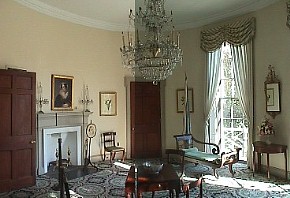
I like how an architect and architectural historian can also be a museum director. It's strange to think that it was an architect who was ultimately most instrumental in getting the Duchamp collection in the Philadelphia Museum of Art--Kimball's letters about his last visit in Los Angeles with the Arensbergs are within A Triumph on Fairmount. Although my favorite 'picture' of Fiske Kimball is:
A woman member brought a friend from New York to visit the museum. Fiske met them in the corridor. To the astonishment of the lady from New York, he knelt and kissed the member's hand. "We are not often honored with such charming visitors," he said. "Allow me to conduct two such exquisite creatures to the latest of our period rooms."
"This is our Louis Quatorze gallery. What things these walls have seen! The Grand Monarque was a great king and a great one for the ladies. What beautiful mistrisses he had! Ah, if you ladies had only lived then he would surely have numbered you among them. Wouldn't you have liked that?" and he dropped to his knees again.
Kimball was forced to retire soon after that.
I actually haven't read any of Kimball's books myself, although I do have A History of Architecture and his "discovery" of the origin of the Rococo is definitely on my to-do list. Yet, I have walked within the Louis Quatorze and Duchamp galleries numerous times. Actions speak louder than words?
Fiske Kimball is a dear recurring character in The Odds of Ottopia and Leaving Obscurity Behind.
| |
2006.05.17 13:17
PHILADELPHIA!!
...I have to go to PNC, the quondam Olney Federal Savings whose early 1960s rebuilding is a reenactment of an early Mies van dar Rohe unbuilt project for a brick country house, 1923. Virtually no one else but me sees this, but I'll bet you anything that's what the architect(s) looked at.
2006.05.22 06:55
genius loci?
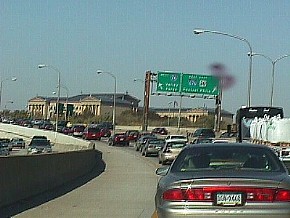 love among the ruins
love among the ruins
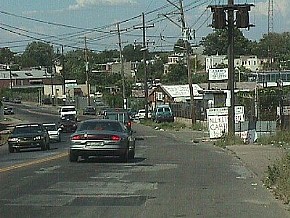 ancient Lenni Lenape trail leading to the summer solstice celebration site
ancient Lenni Lenape trail leading to the summer solstice celebration site
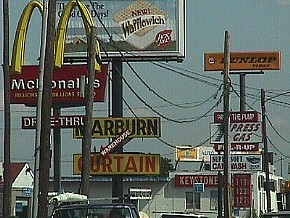 $1.13 a gallon for regular?!?
$1.13 a gallon for regular?!?
|
| |
2006.05.27 11.27
VALU-PLUS
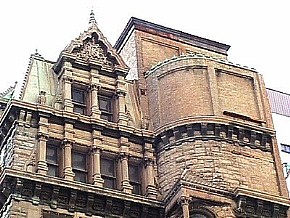 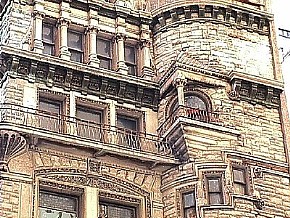 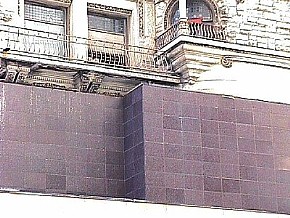 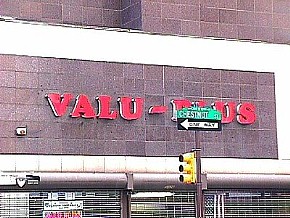 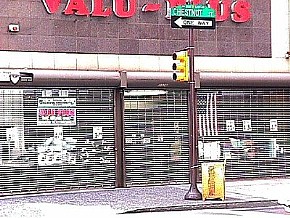
|